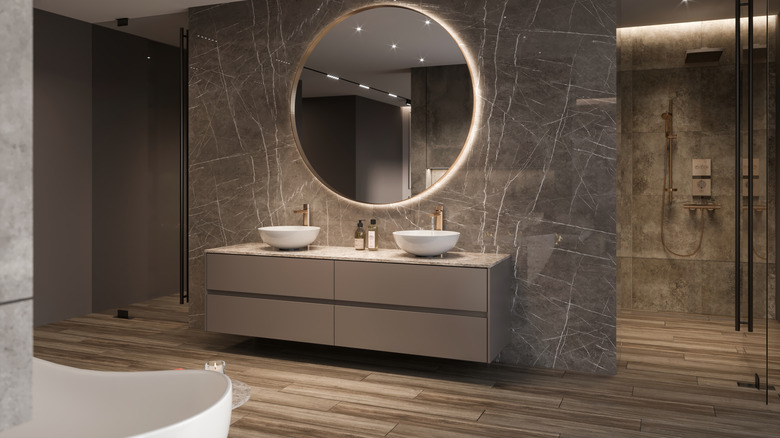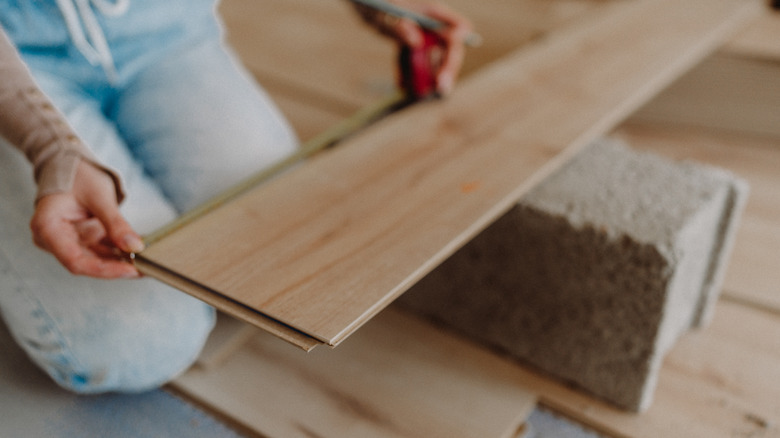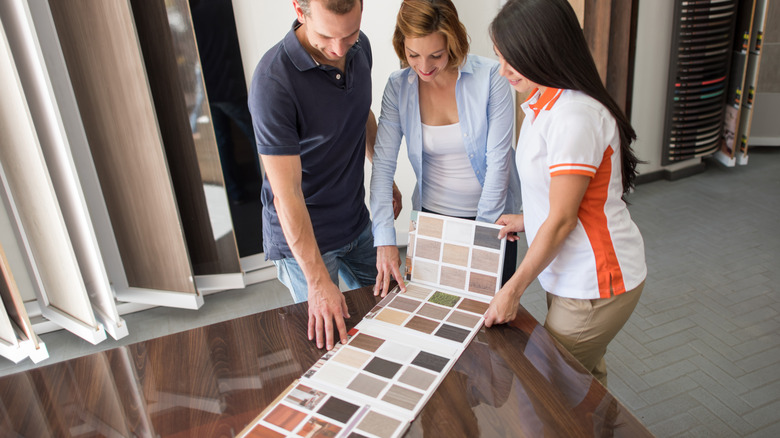Consider This Flooring Option If You Want The Look Of Hardwood In The Bathroom
There's no question that hardwood floors look stunning throughout the home. However, they're not meant to be in every room. Since wood is a porous material, when water gets inside, it can cause the wood to swell, which leads to damage. With repeated exposure to moisture or water, natural hardwood can warp, leading to boards that lose their shape or move from place. Water-damaged floors may have hidden mold and rot as well, creating an unhealthy environment where you're meant to relax. Many people love the look of hardwood, but since it's not a good option for a bathroom, engineered hardwood is a good alternative.
Engineered hardwood flooring has a thin wood veneer but has a core made of plywood. The finish looks nearly identical to hardwood and can be just as durable as its natural counterpart. Plus, because it's a more water-resistant option, it's better for rooms that experience a lot of moisture and water, like bathrooms. Engineered hardwood floors are also generally less expensive than natural hardwood, so it's also a good option if you're looking to do a bathroom renovation on a budget. While there is still maintenance associated with engineered hardwood floors and they're not completely impervious to water damage, they're still, generally, a better option than natural hardwood in the bathroom.
Engineered hardwood is a durable option
Engineered hardwood provides the look of solid hardwood floors without being as susceptible to fluctuations in moisture and humidity. This makes it a good, durable option for bathrooms that might get steamy from hot showers. It's also one of the best flooring options for homes with children because of its water-resistant nature. Kids often splash in the bathtub and leave puddles on the floor when getting out, and engineered hardwood boards won't warp or crack with repeated exposure to water.
However, it's important to remember that engineered hardwood isn't 100% waterproof. While it's more water-resistant than solid hardwood, that doesn't mean you should leave puddles to dry on their own. You'll want to wipe any large water puddles as soon as possible and be cautious when mopping not to leave excess water. Putting down a bathmat outside of the tub or shower to step on will catch excess water after bathing.
Though a durable option, you still have to be cautious about scratches and scruffs with engineered hardwood because of the wood veneer on top of the planks. Opting for hickory, maple, or walnut finishes or other hard varieties of wood can help make the planks less susceptible to scratches. Engineered hardwood, however, is a great option because it can last between 25 to 50 years with proper care, making it a long-term solution for flooring.
An authentic look with a variety of options
Engineered hardwood floors mimic the look of solid hardwood better than any other flooring alternative. This is because it uses real wood as a veneer rather than an image of wood. With engineered hardwood, there is more variation in the color and texture of the boards, creating a look that is much more natural and authentic compared to other wood-alternative materials.
Since it uses real wood veneer, there are plenty of options for color. You'll easily be able to select the right color hardwood and even match engineered hardwood in the bathroom with solid hardwood elsewhere in the house. In some cases, you can also refinish or stain engineered wood floors. You can sand engineered hardwood floors if they're a minimum of 2 millimeters thick, but engineered hardwood veneers that are 4 millimeters or thicker are better for sanding. So, you'll be able to sand and stain engineered hardwood to match hardwood floors if you can't purchase an exact match.
Similarly, there are a variety of options for plank width as well, usually ranging from 150 millimeters to 300 millimeters. Narrower planks have a more traditional look, while wider planks evoke a modern style. You can also take into consideration the size of the room, with wider planks better complementing bigger spaces. The many options of engineered hardwood allow you to create a more customized look in the bathroom.


